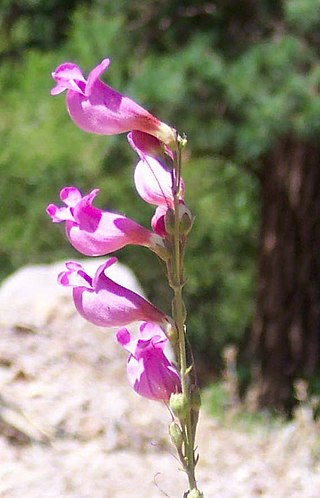Allium punctum is a species of wild onion known by the common name dotted onion or Modoc onion. It is native to the western United States in and around the Modoc Plateau in northeastern California, northwestern Nevada, and southeastern Oregon. It is uncommon, growing in volcanic flatlands created by old lava flows.

Penstemon anguineus is a species of penstemon known by the common name Siskiyou penstemon. It is native to the mountains of southern Oregon and northern California, where it grows in coniferous forests, often in open areas left by logging operations.

Penstemon azureus is a flowering plant species known by the common name azure penstemon. It is native to the mountains of Oregon and northern California. It grows in coniferous forests and woodlands in the Klamath Mountains, North California Coast Ranges, Southern Cascade Range, and Northern Sierra Nevada.

Penstemon barnebyi is a species of penstemon known by the common names White River Valley beardtongue and Barneby's beardtongue. It is native to the mountain and basin territory of central western Nevada, where it grows in sagebrush and woodland; there is also one occurrence just over the California border.

Penstemon bicolor is a species of penstemon known by the common name pinto penstemon. It is native to the desert mountains and valleys of southern Nevada, eastern California, and western Arizona, where it grows in scrub, woodland, and other local habitat. It is a perennial herb which may exceed one meter in maximum height.

Penstemon caesius, commonly known as the San Bernardino penstemon, is a low growing species of flowering plant. It is endemic to California, where it is known from the San Bernardino and San Gabriel Mountains, as well as the southern mountains of the Sierra Nevada. It is a member of the flora on rocky slopes and in coniferous forests and alpine habitat in the mountains.

Penstemon californicus is a species of penstemon known by the common name California penstemon. It is native to Baja California and is also known from fewer than 20 occurrences in California, mainly in Orange and Riverside Counties. It grows in the forest and woodland habitat of the Peninsular Ranges and nearby slopes.

Penstemon centranthifolius is a species of penstemon known by the common name scarlet bugler. It is native to California and parts of Mexico, where it grows in many types of dry habitat from coast to desert, such as chaparral and oak woodland.

Penstemon clevelandii is a species of penstemon known by the common name Cleveland penstemon. It is native to southern California and Baja California, where it grows in mountain and desert habitat such as scrub, woodland, and chaparral.

Penstemon deustus is a species of penstemon known by the common names hotrock penstemon and scabland penstemon. It is native to much of the northwestern United States from the Pacific Northwest to Wyoming, where it grows in many types of forest and open plateau habitat, often on soils heavy in volcanic rock or on limestone outcrops.

Penstemon eatonii is a species of flowering plant in the genus Penstemon, known by the common name firecracker penstemon. It is native to the Western United States from Southern California to the Rocky Mountains. It grows in many types of desert, woodland, forest, and open plateau habitat.

Penstemon filiformis is an uncommon species of Penstemon known by the common name threadleaf penstemon. It is endemic to the Klamath Mountains of northern California, where it grows in forest and woodland, often on serpentine soils.

Penstemon floridus is a species of flowering plant in the plantain family known by the common names Panamint penstemon and rose penstemon.

Penstemon grandiflorus, known by the common names shell-leaved penstemon, shell-leaf beardtongue, or large-flowered penstemon, is a tall and showy plant in the Penstemon genus from the plains of North America. Due to its large flowers it has found a place in gardens, particularly ones aimed at low water usage like xeriscape gardens.

Penstemon davidsonii is a species of penstemon known by the common name Davidson's penstemon, honoring Dr. George Davidson. It is native to western North America.

Penstemon comarrhenus is a perennial plant in the plantain family (Plantaginaceae) found in the Colorado Plateau and Canyonlands region of the southwestern United States.

Penstemon cyanocaulis, the bluestem penstemon or bluestem beardtongue, is a perennial plant in the plantain family (Plantaginaceae) found in the Colorado Plateau and Canyonlands region of the southwestern United States.

Penstemon arenicola, commonly known as Red Desert penstemon, is a species of plant from the Western United States. It primarily grows in Wyoming, but it also grows in small areas of Colorado and Utah. It is a short plant known for growing in sand as referenced by its scientific name.

Penstemon breviculus, the narrow-mouth penstemon or shortstem penstemon, is a species of perennial flowering plant from the dry forests and steppes of the Colorado Plateau in the western United States.

Penstemon ophianthus, the coiled anther penstemon, is a species of small perennial plant in the plantain family. It has very noticeable dark violet lines on its flowers over a lighter blue-lavender color. The species grows in the plateaus and canyon lands of western Colorado and New Mexico, northern Arizona, and southern Utah.




















